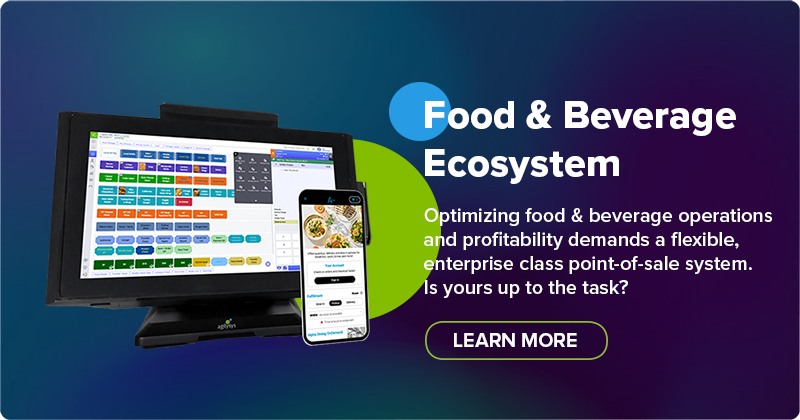
- Solutions
- Food & Beverage Ecosystem
Food & Beverage Ecosystem
Optimizing food & beverage operations and profitability demands a flexible, enterprise-class point-of-sale system. Is yours up to the task?
Go- Hospitality & Leisure Ecosystem
Hospitality & Leisure Ecosystem
From an individual location to an enterprise chain, get the most modern, mobile solution for managing your hospitality business
Go
- Inventory & Procurement Ecosystem
Inventory & Procurement Ecosystem
Designed to optimize foodservice and retail inventory and procurement operations for hotels, resorts, universities, restaurants and others.
Go
- Professional Services
Professional Services
Hospitality businesses are global, 24/7 operations with complex technology demands. You don’t have to go it alone.
Go
- Solution Studios
- Hotels
Hotels
Whether you operate a single boutique location or a large hotel chain, there’s an Agilysys hotel solution for you.
Go- Resorts
Resorts
Whether you operate a single boutique location or a large complex resort, your property is a unique operation that requires robust solutions supported by an experienced technology partner
Go
- Casinos
Casinos
You’re more than a gaming operation. You’re a full-service casino resort property and success isn’t about playing the odds, it’s about making the most of every revenue opportunity.
Go
- Tribal Gaming
Tribal Gaming
A leader in casino hospitality management solutions who respects the sovereignty of your nation.
Go
- Cruise Lines
Cruise Lines
Smooth seas ahead: technology solutions from Agilysys, a leader in cruise management systems.
Go
- Higher Education
- Corporate Dining
Corporate Dining
Identify emerging dining trends while aligning coverage with demand and capturing more revenue.
Go
- Healthcare
Healthcare
Delight patients & visitors, retain staff and grow margins with a suite of hospitality solutions for healthcare environments.
Go
- Life Plan Communities
- Foodservice Management
Foodservice Management
End-to-end foodservice management software solutions for optimum productivity and profitability.
Go
- Stadiums
- Restaurants
- Airports
Airports
Optimizing dozens of food & beverage outlets throughout your facility demands world-class POS performance combined with real-time operating insights.
Go
- Resorts
- Resources
- Articles
Articles
Access our library and read about the latest in emerging technology and other hospitality trends. Find tips and insights on accelerating business growth and improving guest satisfaction.
Go- Customer Stories
Customer Stories
Learn why so many businesses, small and large, partner with Agilysys for their hospitality technology needs.
Go
- Customer Videos
Customer Videos
Watch and learn what Agilysys customers have to say about their experiences with our solutions.
Go
- Product Resources
Product Resources
An in-depth collection of product information and datasheets. Read about the latest in hospitality technology features designed to solve the challenges faced by hospitality professionals around the globe.
Go
- Product Showcase
Product Showcase
Hear from industry professionals about the latest advancements, including tips and tricks, in hospitality and emerging technologies. Check out the library of demo videos and webinar recordings.
Go
- Webinars
Webinars
Watch and learn about the latest in successful technology trends and hear from hospitality professionals in this selection of interactive videos.
Go
- Industry Reports
Industry Reports
Important research and studies from across the hospitality industry. Find out what thought leaders are saying.
Go
- Customer Stories
- Company
- Leadership
- Solution Partners
Solution Partners
Agilysys has a broad collection of partners and APIs to help you assemble the perfect solution for you.
Go
- Our Customers
Our Customers
Discover how Agilysys customers like you are using our solutions to improve their business and guest experience.
Go
- Investor Relations
- News
- Events
Events
With the Agilysys commitment to 100% Hospitality solutions, we take industry events and conferences seriously. Please see where you can find Agilysys to learn more.
Go
- Career
- FAQS
FAQS
Go
- Solution Partners
- Support
- Contact Support
- Microsoft Patch Testing
Microsoft Patch Testing
See what Microsoft products and versions are currently support by Agilysys.
Go
- Payment Center
- RMA Requests
- Supply Order
Supply Order
Go
- Hospitality IQ
Hospitality IQ
Go
- Knowledge Center
Knowledge Center
Go
- Microsoft Patch Testing
- Blogs
- MyAgilysys
-
 Get a Demo
Get a Demo 877 369 6208
877 369 6208
×Home
☰- Explore
WHAT'S THE BUZZ IN HOSPITALITY?
Revolutionizing Food Service: 10 Reasons to Upgrade Your POS System in Food Service Management in 2025
The food service industry is undergoing a significant transformation in how customers interact with dining services. Traditionally, Point of Sale (POS) meant a fixed terminal with an employee taking orders from guests across a counter. Today's reality is radically different, with guests expecting to order and pay however they prefer, whether through their phones, at self-service kiosks, via apps, or through traditional staff interactions. As consumer expectations evolve, traditional POS systems are struggling to keep pace. Below are the top 10 reasons to consider replacing your POS system in 2025, along with actionable insights to help food service leaders prepare for the future.
1. Omnichannel Ordering Revolution
Modern consumers expect seamless dining experiences, whether ordering via mobile apps, self-service kiosks, or traditional staff interactions. In environments like airports, where quick service is crucial, implementing POS systems that support multiple ordering channels can significantly enhance customer satisfaction. At college campuses, where students may have varying schedules and dining preferences, POS systems that offer flexibility and convenience are essential. Similarly, in corporate cafeterias, employees value the ability to quickly place orders via mobile or kiosks, reducing wait times during busy lunch hours.
For example, stadiums have reported a 45% reduction in average wait times by utilizing intelligent queue management algorithms integrated with their POS systems. Similarly, amusement parks are benefiting from seamless ordering and faster service using similar technologies that improve guest experiences.

The global restaurant point-of-sale terminal market was valued at $22.26 billion in 2023 and is projected to grow at a compound annual growth rate (CAGR) of 8.0% from 2023 to 2030, reaching approximately $38.16 billion by 2030. This highlights the growing importance of efficient POS solutions across food service industries.
Tip: Look for POS systems that maintain consistent service quality across all channels while giving guests choice in how they interact.
2. Unified Operations Platform
Managing orders from various sources—whether from kiosks, mobile apps, or traditional service points—can overwhelm kitchen operations, leading to delays and errors. Modern POS systems bring order to chaos by consolidating orders from multiple channels into a single platform, allowing kitchens to efficiently manage and prioritize tasks. This integration ensures consistent service quality, regardless of how orders are placed.
For instance, hospitals that provide meal services to patients across different units and assisted living facilities that cater to varying dietary needs benefit greatly from a unified POS system that manages multiple order types and preferences. Even in amusement parks, where guests are spread out over large areas, a unified POS helps ensure smooth operations across different dining locations.
Tip: Choose a system that helps your kitchen deliver consistency regardless of how guests place their orders.
3. Single Source of Configuration
When updating menus, prices, or promotions, changes should happen once and deploy everywhere. Modern systems eliminate the complexity of managing multiple platforms by providing a single point of control. With a browser-based solution, these configurations can be performed from anywhere, giving you the flexibility to manage your operation remotely. Whether you're adding a daily special or updating your entire menu, every guest-facing service point stays automatically synchronized, whilst also allowing you to maintain an element of local differentiation.
This approach is especially beneficial in corporate cafeterias where standardization is key but customization is still important for different office locations. Similarly, at amusement parks, offering varying food options across several stands and carts can be simplified with a unified POS platform.
Tip: Select a system that simplifies operations through centralized management of all customer touchpoints.
4. Ultimate Terminal Flexibility
Today’s food service environments demand flexible service solutions that adapt to different settings and staff preferences. Your servers might prefer tablets for poolside service while your counter staff need fixed terminals — modern POS solutions should support both. This flexibility extends to your choice of devices, from consumer-grade tablets for lighter service points to commercial-grade terminals for high-volume areas, or a combination of both within the same environment.

For hospitals and assisted living facilities, where quick and accurate ordering is critical to patient care, POS systems that integrate seamlessly with mobile devices for in-room service are increasingly important. In stadiums, flexibility allows staff to process orders at seats with mobile devices, cutting down wait times for guests.
Tip: Select a system that lets you choose the right device for each service scenario while ensuring consistent guest and staff experience across all points of service.
5. Ultimate Mobility
In venues like amusement parks and airports, staff mobility is crucial. Modern POS systems enable staff to process orders and payments from anywhere within the venue, enhancing service speed and customer satisfaction. This mobility ensures that staff can assist customers promptly, regardless of their location within the facility.
Mobile POS systems have been shown to improve service in remote areas of amusement parks, where service coverage might have been limited before. Similarly, college campuses benefit from mobility, allowing dining staff to serve customers on-the-go during high-traffic hours.
Tip: Look for systems that enable your staff to provide full-service experiences anywhere on your property.
6. Highly Scalable Architecture
Whether managing a single cafeteria or multiple dining locations across a campus, POS systems must scale accordingly. Modern POS solutions offer scalability, allowing businesses to expand operations without compromising performance. This scalability is essential in environments like hospitals, where dining services may need to adapt to varying patient volumes and dietary requirements.
POS solutions that scale have been a key factor in the food service management industry's ability to handle diverse needs across multiple locations, from small cafeterias to large venues like stadiums and airports.
Tip: Choose a system that can grow with your business while maintaining performance and reliability.
7. Centralized Enterprise Configuration
For food service chains, it’s essential to balance consistency with local market needs. Your POS should allow central control of core menus and pricing while giving branches freedom to add local specialties and adjustments. This flexibility ensures guests enjoy consistent brand experiences while appreciating local flavors.
This is particularly beneficial in corporate cafeterias where standardization is important, but accommodating local tastes can enhance employee satisfaction.
Tip: Look for systems that balance brand standards with the flexibility to meet unique local market requirements.

8. Open APIs
Integrating POS systems with other technologies, such as ticketing platforms in stadiums or patient management systems in hospitals, enhances operational efficiency. Modern POS solutions offer robust integration capabilities, allowing businesses to create customized service experiences without backend complexity.
For example, integrating POS systems with ticketing platforms in stadiums can streamline operations and improve the fan experience.
Tip: Evaluate systems based on their ability to integrate smoothly with your existing guest service platforms.
9. Global Coverage
Supporting diverse payment methods and adapting to regional preferences is essential, especially in international airports and amusement parks that cater to a global audience. Your POS system should support local preferences and global standards and cross-pollinate innovation from around the world to ensure you can cater to a global audience.
The POS payment market is expected to grow significantly, with mobile POS payments projected to reach $5.63 trillion by 2027, underlining the importance of versatile payment systems in these environments.
Tip: Select a system that can adapt to both local and global guest preferences.
10. Platform of the Future
The food service industry is rapidly evolving, and POS systems must keep pace with technological advancements. Choosing a solution that continuously incorporates new technologies and service capabilities ensures businesses can adapt to changing customer expectations and industry trends.
For instance, implementing self-service kiosks in school cafeterias has been shown to improve efficiency and customer satisfaction, with many schools reporting a 25% reduction in food service wait times.
Tip: Partner with providers who demonstrate consistent innovation in guest service capabilities.
Adopting modern POS systems tailored to the unique needs of food service management in venues such as airports, stadiums, college campuses, corporate cafeterias, hospitals, assisted living facilities, and amusement parks can significantly enhance operational efficiency and customer satisfaction. By embracing these technologies, businesses can stay competitive and meet the evolving demands of today's consumers.

The 2024 Global Hospitality Study
Download Study
Visit Agilysys At These Events
Learn More
2025 Hospitality Industry Conferences You Shouldn't Miss
Read MoreCategories
- Contact Support
- Leadership
- Articles
- Hotels
- Food & Beverage Ecosystem





